
Neutron Scattering in Biology - Fitter Gutberlet and Katsaras
.pdf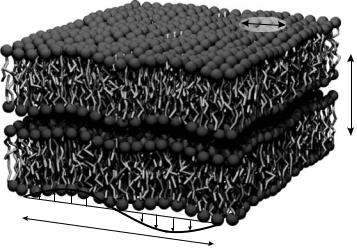
22 Structure and Dynamics of Model Membrane Systems |
519 |
Static and dynamic
Correlation length scale
ξ
dz
Undulation lu
modes
Fig. 22.8. Schematic of a double bilayer with some elementary excitations and the corresponding length scales. Apart from undulation modes with typical wavelengths of several hundred ˚Angstr¨oms, the short wavelength correlations and dynamics in the plane of the membrane can be probed by coherent neutron scattering. The corresponding length scale ξ is thereby in the order of 20 ˚A. dz is the bilayer thickness
X-ray scattering are related to the energy–momentum relation of the neutron versus the photon probe, strongly a ecting energy resolution, and accessible (Q,ω) range. At high Q the energy of the incident neutrons is in the range of the excitations (some microelectron volts) resulting in a high energy resolution (up to 300 eV), in comparison to 1.5 meV of the inelastic X-ray experiment. A better energy resolution in combination with a smaller ratio between central peak and Brillouin amplitudes leads to very pronounced satellites, which are easier to evaluate. This is of particular advantage for the identification of peaks in the central part of the dispersion relation, as well as for the experimental verification of a predicted nondispersive mode at high energies, as shown later. Due to the dispersion relation of the neutron itself ( Q2), the range at low Q and high ω values is di cult to access by INS. The determination of the exact speed of sound is therefore a domain of inelastic X-ray scattering.
The collective dynamics of the lipid acyl chains in the model system DMPC (-d54, deuterated 1,2-dimyristoyl-sn-glycero-3-phosphatidylcholine), were studied by INS. By selective deuteration of the chains, the respective motions are strongly enhanced over other contributions to the inelastic scattering
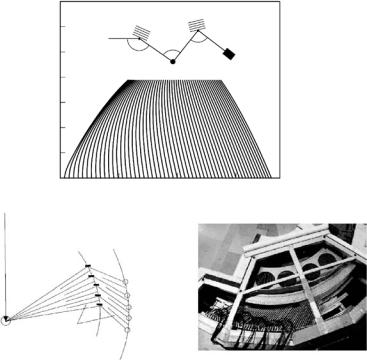
22 Structure and Dynamics of Model Membrane Systems |
521 |
and the energies Ei and Ef of the incident and the scattered beam, respectively, can be determined. Q, the momentum transfer to the sample, and the energy transfer, ω, are then defined by the laws of momentum and energy conservation:
Q = k f − ki and ω = Ei − Ef . |
(22.6) |
The accessible (Q,ω) range of IN12 for a fixed energy of the scattered beam Ef of 10 meV is shown in Fig. 22.9 and covers very well the range of the excitations expected in phospholipid model membranes. It is limited by the range of incident neutron energies o ered by the neutron guide as well as by mechanical restrictions of the spectrometer. The instrumental energy resolution in this configuration is ∆ω = 500 eV. By choosing smaller incident energies and energy transfers the energy resolution can be enhanced. A detailed description of the experimental set-up and method can be found elsewhere [57, 58].
With a conventional TAS, single points in (Q,ω) space are scanned one by one. A more e cient use of the triple-axis technique is achieved by multiplexing, i.e., the use of several independent analyzer blades and position-sensitive detectors to investigate multiple (Q,ω) points at the same time. This option is implemented on the spectrometer IN3 by the usage of a multianalyzer detector. A schematic of the set-up is shown in Fig. 22.9a; Fig. 22.9b shows a photograph of the detector unit with analyzers and 3He counter tubes (for a detailed description of the set-up see Demmel et al., [59]).
The use of the multidetector is especially useful in systems with restricted dimensions. Considering the membranes as stacked two-dimensional layers, only two directions in space can be di erentiated, i.e., the plane of the bilayer, Qr , or the normal to it, Qz . Because of the missing periodicity in the third direction in space the scattered intensity is distributed rod-like in reciprocal space. The scattering is independent of one of the reciprocal axis and this allows to measure di erent Q vectors of the sensitive reciprocal axis at the same time in the di erent channels of the multi analyzer. The dispersion relation can therewith be measured for several Q-points at the same time. Considering elastic scattering, large areas of reciprocal space can be measured (or mapped) simultaneously.
22.5.2 Elastic Neutron Scattering
The use of a TAS o ers the possibility of measuring the static structure factor in the plane of the membranes, S(Qr ), the in-plane dynamics, S(Qr , ω), and the reflectivity on the same instrument in the same run without changing the setup (di raction is measured at energy transfer ω = 0). This is an invaluable advantage as the thermodynamic state of the lipid bilayer not only depends on temperature and relative humidity, but also on cooling and heating rates, preparation and thermal history. The combination of elastic and inelastic measurements (see later) leads to a complete picture of structure and (collective) dynamics of model membranes on a molecular length scale.
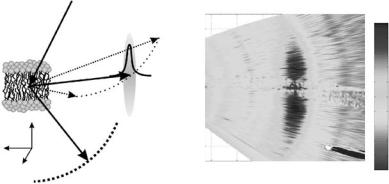
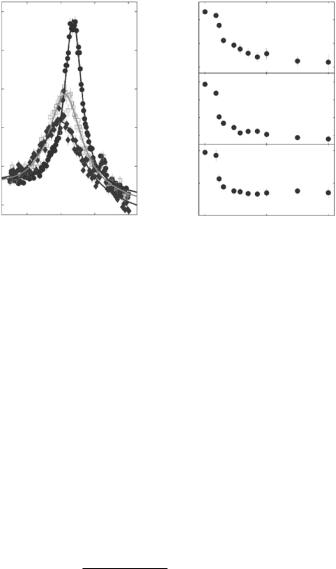
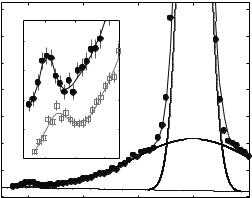
524 T. Salditt, M.C. Rheinst¨adter
|
700 |
Qr =1.0 Å−1 |
|
|
|
||
|
600 |
60 |
Pb´T=20˚C |
|
|
|
|
counts |
500 |
50 |
|
|
|
|
|
400 |
40 |
|
|
|
|
|
|
|
|
|
|
|
|
||
Neutron |
|
|
|
|
|
|
|
300 |
30 |
|
|
|
|
|
|
|
|
La T=20˚C |
|
|
|||
200 |
|
|
|
|
|||
|
|
|
|
|
|||
|
|
|
|
|
|
|
|
|
|
20 |
−6 |
−5 |
−4 |
Pb,´ T=20˚C |
|
|
100 |
|
|
||||
|
|
|
|
|
Qr =1.0 Å−1 |
|
|
|
0 |
|
−6 |
−4 |
−2 |
0 |
2 |
|
|
|
|||||
w (meV)
Fig. 22.12. Energy scan at a Qr = 1.0 ˚A−1 in the gel phase of the bilayer. The inset shows the excitations of the bilayer in the gel (top) and the fluid phase (bottom)
associated with intramolecular degrees of freedom and incoherent scattering, not seen by inelastic X-ray scattering. The solid line in Fig. 22.12 is a fit by the three-e ective eigenmode model with an additional Lorentzian component.
Figure 22.13a shows the dispersion relation in the gel and the fluid phase as measured by several constant Q-scans at Q-values ranging from Q = 0.7 to 3.0 ˚A−1. The fluid dispersion has been measured far in the fluid phase of the DMPC bilayer. At small Qr , longitudinal sound waves in the plane of the bilayer are probed and give rise to a linear increase of ω Qr , saturating at some maximum value (“maxon”), before a pronounced minimum Ω0 (“roton”) is observed at Q0 1.4 ˚A−1, the first maximum in the static structure factor S(Qr ) (the interchain correlation peak). Qualitatively, this can be understood if Q0 is interpreted as the quasi-Brillouin zone of a two-dimensional liquid. Collective modes with a wavelength of the average nearest neighbor distance 2π/Q0 are energetically favorable, leading to the found minimum. At Qr values well above the minimum, the dispersion relation is dominated by single particle behavior. The inelastic neutron data are less noisy and cover a wider range as compared to inelastic X-ray scattering [56]. A quantitative theory that predicts the absolute energy values of “maxon” and “roton” on the basis of molecular parameters is absent so far. However, the dispersion relation can be extracted from MD simulations by temporal and spatial Fourier transformation of the molecular real space coordinates [64] which shows excellent agreement.
Figure 22.13b shows corresponding energy scans taken at Q = 1.5 ˚A−1 in the dispersion minimum for temperatures T between 20 and 40◦C. In the gel phase an excitation at ωs = −1 meV is found. At higher temperatures, the gel excitations decreases and a new excitation at energy values of ωs = −2 meV grows associated with the fluid phase. Clearly the excitations are not spurious
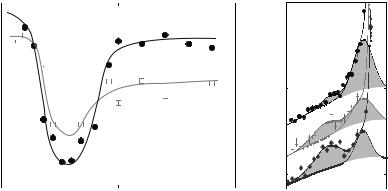
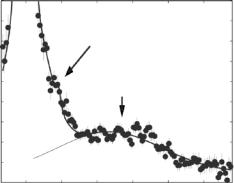
528 T. Salditt, M.C. Rheinst¨adter
C. Ollinger for enjoyable collaborations on some of the original work discussed here, R. Siebrecht and V. Leiner for excellent support at ADAM, F. Demmel for help on the IN3 multidetector, G. Fragneto for experimental support and discussions and G. Brotons for helpful discussions regarding the data analysis. Financial aid by the Deutsche Forschungsgemeinschaft (DFG) through grants SA-772/3 and SA-772/4 and by the German Research Ministry under contract numbers 05300CJB6 and 05KS1TSA7 is gratefully acknowledged.
References
1.R. Lipowsky, E. Sackmann (eds.), Structure and Dynamics of Membranes, Vol. 1, Handbook of Biological Physics (Elsevier, North-Holland, Amsterdam, 1995)
2.G. B¨uldt, H.U. Gally, J. Seelig, G. Zaccai, J. Mol. Biol. 135 (1979), 673
3.M. Seul, M.J. Sammon, Thin Solid Films 185 (1990), 287
4.C.M. M¨unster, T. Salditt, M. Vogel, R. Siebrecht, J. Peisl, Europhys. Lett. 46 (1999), 486
5.J. Katsaras, Biophys. J. 75 (1998), 2157
6.J.F. Nagle, J. Katsaras, Phys. Rev. E 59 (1999), 7018
7.M. Vogel, C. M¨unster, W. Fenzl, T. Salditt, Phys. Rev. Lett. 84 (2000), 390
8.T. Salditt, C. M¨unster, J. Lu, M. Vogel, W. Fenzl, A. Souvorov, Phys. Rev. E 60 (1999), 7285
9.S.K. Sinha, E.B. Sirota, S. Garo , H.B. Stanley, Phys. Rev. B 38 (1988), 2297
10.R. Pynn, Phys. Rev. B 45 (1992), 602
11.C. M¨unster, PhD thesis, Sektion Physik, Universit¨at M¨unchen, 2000
12.J. Als-Nielsen, D. McMorrow, Elements of Modern X-Ray Physics (John Wiley & Sons, New York, 2001)
13.T. Salditt, C. Li, A. Spaar, U. Mennicke, Eur. Phys. J. E 7 (2002), 105
14.G. Pabst, M. Rappolt, H. Amenitsch, P. Laggner, Phys. Rev. E 62 (2000), 4000
15.A.E. Blaurock, Biochem. Biophys. Acta 650 (1982), 167
16.J. Katsaras, Biochem. Cell. Biol. 73 (1995), 209
17.T. Salditt, Curr. Opin. Coll. Interface Sci. 19 (2000), 232
18.D. Constantin, U. Mennicke, C. Li, T. Salditt, Eur. Phys. J. E 12 (2003), 283
19.U. Mennicke, PhD thesis, Institut f¨ur R¨ontgenphysik, Georg-August-Universit¨at G¨ottingen, 2003
20.C.R. Safinya, E.B. Sirota, D. Roux, G.S. Smith, Phys. Rev. Lett. 57 (1986), 2718
21.C.R. Safinya, E.B. Sirota, D. Roux, G.S. Smith, Phys. Rev. Lett., 62 (1989), 1134
22.J.F. Nagle, H.I. Petrache, N. Gouliaev, S. Tristram-Nagle, Y. Liu, R.M. Suter, K. Gawrisch, Phys. Rev. E, 58 (1998), 7769
23.H.I. Petrache et al., Phys. Rev. E 57 (1998), 7014
24.R.P. Rand, V.A. Parsegian, Biochim. Biophys. Acta 988 (1989), 351
25.T. Salditt, C. M¨unster, U. Mennicke, C. Ollinger, G. Fragneto, Langmuir 19 (2003), 7703
26.G. Smith, E.B. Sirota, C.R. Safinya, N.A. Clark, Phys. Rev. Lett. 60 (1988), 813
27.R.K. Thomas, J. Penfold, Curr. Opin. Coll. Interface Sci. 1 (1995), 23
28.T.M. Bayerl, R.K. Thomas, A. Rennie, J. Penfold, E. Sackmann, Biophys. J. 60 (1991), 1
